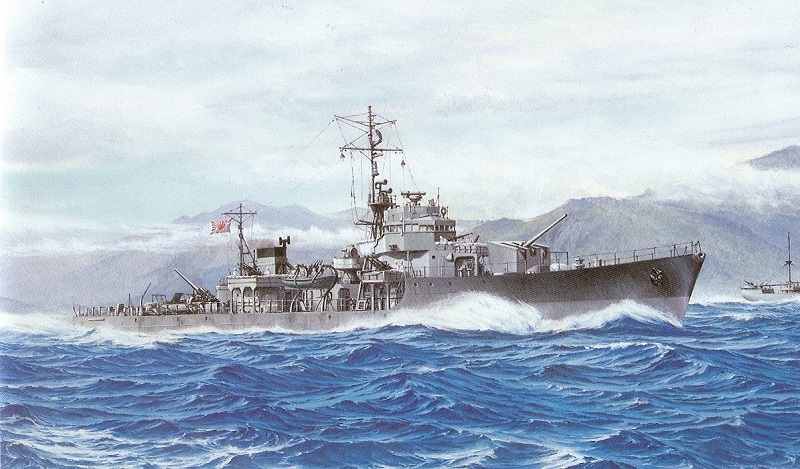© 2006-2014 Bob Hackett, Sander Kingsepp and Peter Cundall
Revision 2
25 November 1944:
Maizuru Naval Yard. Laid down.
12 February 1945:
Launched and named IWO. [1]
24 March 1945:
Completed and registered in the Sasebo Naval District. LtCdr Kodera Touji is the Commanding Officer. Attached to the Kure Guard Unit.
March - April 1945:
Undergoes training and conducts anti-submarine exercises in Nanao Bay.
23 April 1945:
IWO and HODAKA arrive at Maizuru.
24 April 1945:
IWO and HODAKA depart Maizuru for Nanao.
5 May 1945:
Reassigned to the Maizuru Naval District in the newly formed 51st Division.
1 June 1945:
Arrives at Ominato, Honshu.
13 June 1945:
USAAF XXth Air Force B-29 "Super Fortress" heavy bombers mine Shimonoseki Straits and the waters off Niigata. IWO strikes one of the mines 1 mile SE of Kannonzaki and is damaged.
14 July 1945:
Departs Hachinohe, Honshu. Soon after departure, IWO is attacked by aircraft from Rear Admiral (later Admiral) Arthur W. Radford’s (USNA ’16) Task Group 38.4’s USS SHANGRI-LA (CV-38). Although subjected to attacks from 0430-1000, IWO sustains little damage, but four crewmen are KIA and 61 wounded.
1 August 1945:
Reassigned to the 104th Escort Squadron at Maizuru.
15 August 1945:
Wakkanai, Hokkaido. IWO’s crew is notified of the termination of war.
5 October 1945:
Removed from the Navy List.
October 1945:
Remodeled to a special cargo ship.
29 October 1945:
Departs Maizuru on her first repatriation voyage.
6 November 1945:
Arrives at Manila. Embarks troops and passengers to be repatriated.
8 November 1945:
Departs Manila.
14 November 1945:
Arrives at Kagoshima. Disembarks troops and passengers.
29 November 1945:
Departs Kure.
1 December 1945:
Officially assigned to the Allied Repatriation Service. [2]
7 December 1945:
Arrives at Manila. Embarks troops and passengers to be repatriated.
8 December 1945:
Departs Manila.
16 December 1945:
Arrives at Otaka. Disembarks troops and passengers.
1 January 1946:
Undergoes repairs at Tamano.
23 January 1946:
Completes repairs.
27 January 1946:
Departs Kure.
28 January 1946:
Arrives at Kagoshima. Disembarks troops and passengers.
29 January 1946:
Departs Kagoshima.
31 January 1946:
Arrives at Ishigaki Shima. Embarks troops and passengers to be repatriated and departs later the same day.
1 February 1946:
Arrives at Kirun (Keelung). Embarks troops and passengers to be repatriated.
2 February 1946:
Departs Kirun.
4 February 1946:
Arrives at Kagoshima. Disembarks troops and passengers.
7 February 1946:
Departs Kagoshima.
9 February 1946:
Arrives at Kirun. Embarks troops and passengers to be repatriated.
10 February 1946:
Departs Kirun.
12 February 1946:
Arrives at Kagoshima. Disembarks troops and passengers.
14 February 1946:
Undergoes repairs at Tamano.
1 March 1946:
Completes repairs.
3 March 1946:
Departs Tamano.
5 March 1946:
Arrives at Sasebo. Disembarks troops and passengers.
6 March 1946:
Departs Sasebo.
9 March 1946:
Arrives at Kirun. Embarks troops and passengers to be repatriated.
10 March 1946:
Departs Kirun.
12 March 1946:
Arrives at Kagoshima. Disembarks troops and passengers.
2 July 1948:
Sasebo shipyard. Begins scrapping.
Authors' Note:
[1] IWO was also known as IO.
[2 Allied occupation forces were responsible for the return of six million Japanese military personnel and civilians from Japan's defunct far-flung Empire. In addition, there were over a million Korean and about 40,000 Chinese prisoners and conscript laborers and approximately 7,000 Formosans and 15,000 Ryukyu Islanders to be repatriated.
Some Allied and many former IJN warships, from aircraft carriers to kaibokan, were used to facilitate the enormous repatriation effort. Japanese vessels and crews were used to the fullest extent possible to conserve Allied manpower and accelerate demobilization. Each ex-IJN ship first had to be demilitarized; guns removed or, in the case of large warships, barrels severed, ammunition landed, and radar and catapults removed, if fitted. Repatriation of the Chinese on Japanese ships began early in October from Hakata, but U.S. guard detachments had to be placed on many ships to prevent disorder because the Japanese crews could not control the returnees.
Japanese-run repatriation centers were established at Kagoshima, Hario near Sasebo, and Hakata near Fukuoka. Other reception centers were established and operated at Maizuru, Shimonoseki, Sasebo, Senzaki, Kure, Uraga, Yokohama, Moji and Hakodate. Allied line and medical personnel supervised the centers. Incoming Japanese were sprayed with DDT, examined and inoculated for typhus and smallpox, provided with food, and transported to his final destination in Japan.
Thanks for assistance go to Dr. Higuchi Tatsuhiro of Japan and Mr. Gilbert Casse of France. Thanks also go to Jeff Donahoo of Iowa for help in identifying kaibokan COs.
-Bob Hackett, Sander Kingsepp and Peter Cundall.
Back to
Escort Page



